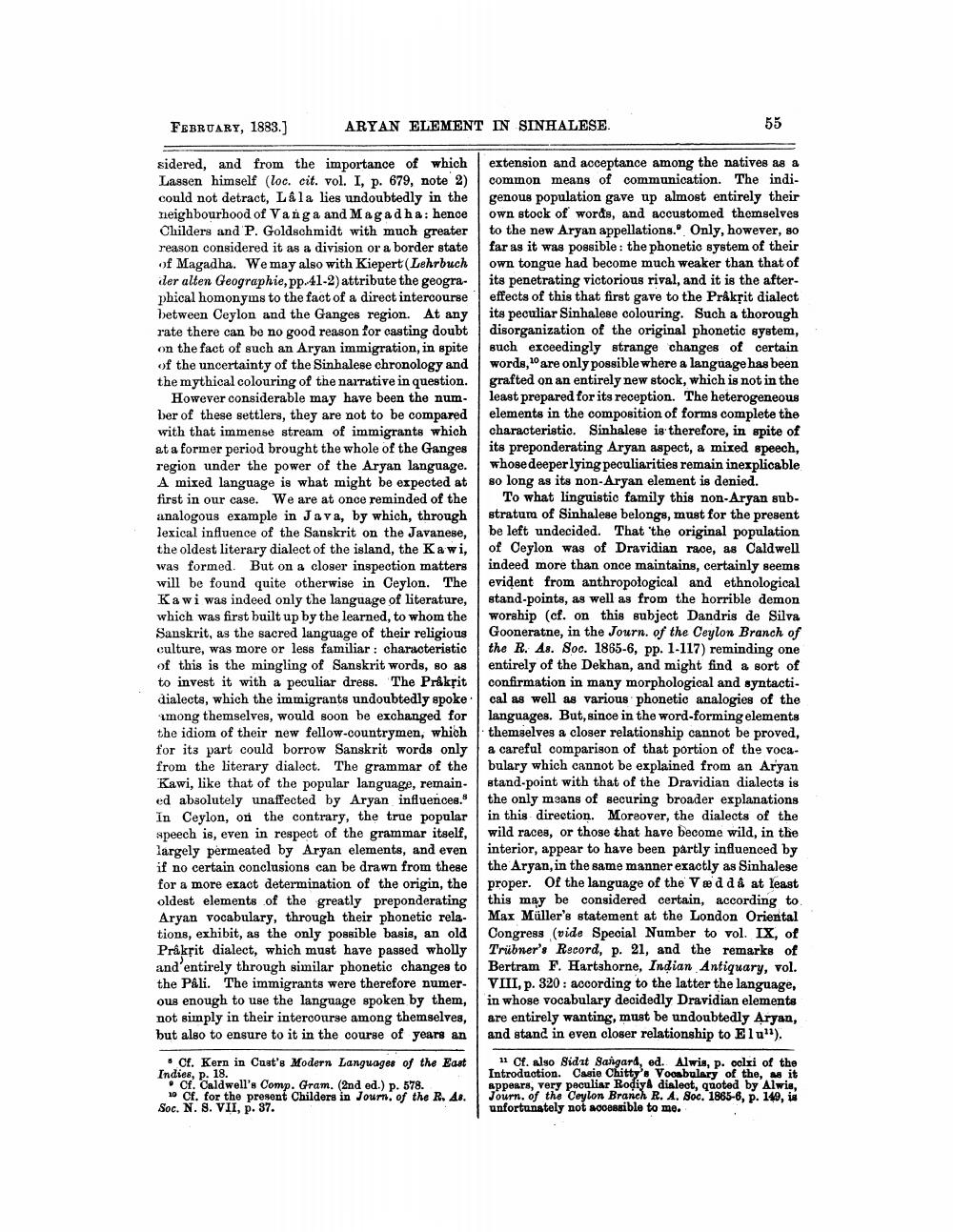________________
FEBRUARY, 1883.)
ARYAN ELEMENT IN SINHALESE.
55
sidered, and from the importance of which extension and acceptance among the natives as a Lassen himself (loc. cit. vol. I, p. 679, note 2) common means of communication. The indicould not detract, La la lies undoubtedly in the genous population gave up almost entirely their neighbourhood of Vanga and Magadha: hence own stock of words, and accustomed themselves Childers and 'P. Goldschmidt with much greater to the new Aryan appellations. Only, however, 80 reason considered it as a division or a border state far as it was possible: the phonetic system of their of Magadha. We may also with Kiepert(Lehrbuch own tongue had become much weaker than that of der alten Geographie, pp.41-2) attribute the geogra- its penetrating victorious rival, and it is the afterphical homonyms to the fact of a direct intercourse effects of this that first gave to the Prakrit dialect between Ceylon and the Ganges region. At any its peculiar Sinhalese colouring. Such a thorough rate there can be no good reason for casting doubt disorganization of the original phonetic system, on the fact of such an Aryan immigration, in spite Buch exceedingly strange changes of certain of the uncertainty of the Sinhalese chronology and words, are only possible where a language has been the mythical colouring of the narrative in question. grafted on an entirely new stock, which is not in the
However considerable may have been the num- least prepared for its reception. The heterogeneous ber of these settlers, they are not to be compared elements in the composition of forms complete the with that immense stream of immigrants which characteristio. Sinhalese is therefore, in spite of at a former period brought the whole of the Ganges its preponderating Aryan aspect, a mixed speech, region under the power of the Aryan language. whose deeperlying peculiarities remain inexplicable A mixed language is what might be expected at so long as its non-Aryan element is denied. first in our case. We are at once reminded of the To what linguistic family this non-Aryan subanalogous example in Java, by which, through stratum of Sinhalese belongs, must for the present lexical influence of the Sanskrit on the Javanese, be left undecided. That 'the original population the oldest literary dialect of the island, the Kawi, of Ceylon was of Dravidian race, as Caldwell was formed. But on a closer inspection matters indeed more than once maintains, certainly seems will be found quite otherwise in Ceylon. The evident from anthropological and ethnological Kawi was indeed only the language of literature, stand-points, as well as from the horrible demon which was first built up by the learned, to whom the worship (cf. on this subject Dandris de Silva Sanskrit, as the sacred language of their religious Gooneratne, in the Journ. of the Ceylon Branch of culture, was more or less familiar: characteristic the R. As. Soc. 1865-6, pp. 1-117) reminding one of this is the mingling of Sanskrit words, 80 as entirely of the Dekhan, and might find a sort of to invest it with a peculiar dress. The Prakrit confirmation in many morphological and syntactidialects, which the immigrants undoubtedly spoke cal as well as various phonetic analogies of the among themselves, would soon be exchanged for languages. But, since in the word-forming elements the idiom of their new fellow-countrymen, which themselves a closer relationship cannot be proved, for its part could borrow Sanskrit words only a careful comparison of that portion of the vocafrom the literary dialect. The grammar of the bulary which cannot be explained from an Aryan Kawi, like that of the popular language, remain- stand-point with that of the Dravidian dialects is ed absolutely unaffected by Aryan influences. | the only means of securing broader explanations In Ceylon, on the contrary, the true popular in this direction. Moreover, the dialects of the speech is, even in respect of the grammar itself, wild races, or those that have become wild, in the largely permeated by Aryan elements, and even interior, appear to have been partly influenced by if no certain conclusions can be drawn from these the Aryan, in the same manner exactly as Sinhalese for a more exact determination of the origin, the proper. Of the language of the Vædd & at least oldest elements of the greatly preponderating this may be considered certain, according to Aryan vocabulary, through their phonetic rela- Max Müller's statement at the London Oriental tions, exhibit, as the only possible basis, an old Congress (vide Special Number to vol. IX, of Pråkpit dialect, which must have passed wholly Tribner's Record, p. 21, and the remarks of and'entirely through similar phonetic changes to Bertram F. Hartshorne, Indian Antiquary, vol. the Pâli. The immigrants were therefore numer- VIII, p. 320 : according to the latter the language, ous enough to use the language spoken by them, in whose vocabulary decidedly Dravidian elements not simply in their intercourse among themselves, are entirely wanting, must be undoubtedly Aryan, but also to ensure to it in the course of years an and stand in even closer relationship to Elu").
. cf. Kern in Cuat's Modern Languages of the East 11 Cf. also sidat Sangard, ed. Alwis, p. cclxi of the Indies, p. 18.
Introduction. Casie Chitty's Vooabulary of the, as it . Cf. Caldwell's Comp. Gram. (2nd ed.) p. 578.
appears, very peculiar Rodiya dialect, quoted by Alwis, 10 Cf. for the present Childers in Journ of the R.As. Journ. of the Ceylon Branch R. A. Soc. 1865-6, p. 149, is Soc. N. S. VII, p. 37.
unfortunately not accessible to me.




